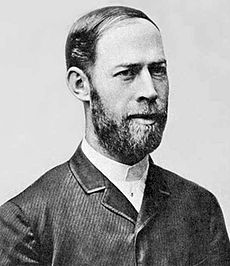Heinrich Rudolf Hertz
| Heinrich Hertz | |
|---|---|
 |
|
| Born | Heinrich Rudolf Hertz 22 February 1857 Hamburg, German Confederation |
| Died | 1 January 1894 (aged 36) Bonn, German Empire |
| Residence | Germany |
| Nationality | German |
| Fields |
Physics Electronic Engineering |
| Institutions |
University of Kiel University of Karlsruhe University of Bonn |
| Alma mater |
University of Munich University of Berlin |
| Doctoral advisor | Hermann von Helmholtz |
| Doctoral students | Vilhelm Bjerknes |
| Known for |
Electromagnetic radiation Photoelectric effect Hertz's principle of least curvature |
| Notable awards |
Matteucci Medal (1888) Rumford Medal (1890) |
| Signature | |
Heinrich Rudolf Hertz (German: [hɛɐʦ]; 22 February 1857 – 1 January 1894) was a German physicist who first conclusively proved the existence of the electromagnetic waves theorized by James Clerk Maxwell's electromagnetic theory of light. Hertz proved the theory by engineering instruments to transmit and receive radio pulses using experimental procedures that ruled out all other known wireless phenomena. The unit of frequency – cycle per second – was named the "hertz" in his honor.
Heinrich Rudolf Hertz was born in 1857 in Hamburg, then a sovereign state of the German Confederation, into a prosperous and cultured Hanseatic family. His father Gustav Ferdinand Hertz (originally named David Gustav Hertz) (1827–1914) was a barrister and later a senator. His mother was Anna Elisabeth Pfefferkorn.
Hertz's paternal grandfather, Heinrich David Hertz (originally named Hertz Hertz) (1797–1862), was a businessman, and his paternal grandmother, Bertha "Betty" Oppenheim, was the daughter of the banker Salomon Oppenheim, Jr. from Cologne.
Hertz's paternal great-grandfather, David Wolff Hertz (1757–1822), fourth son of Benjamin Wolff Hertz, moved to Hamburg in 1793, where he made his living as a jeweller; he and his wife Schöne Hertz (1760–1834) were buried in the former Jewish cemetery in Ottensen. Their first son, Wolff Hertz (1790–1859), was chairman of the Jewish community.
...
Wikipedia

